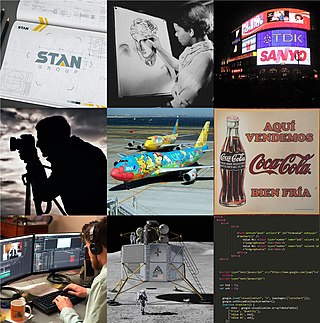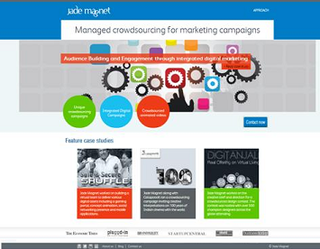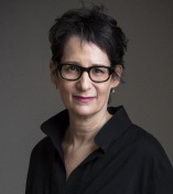Related Research Articles

Graphic design is a profession, academic discipline and applied art whose activity consists in projecting visual communications intended to transmit specific messages to social groups, with specific objectives. Graphic design is an interdisciplinary branch of design and of the fine arts. Its practice involves creativity, innovation and lateral thinking using manual or digital tools, where it is usual to use text and graphics to communicate visually.
Topcoder is a crowdsourcing company with an open global community of designers, developers, data scientists, and competitive programmers. Topcoder pays community members for their work on the projects and sells community services to corporate, mid-size, and small-business clients. Topcoder also organizes the annual Topcoder Open tournament and a series of smaller regional events.

Crowdsourcing involves a large group of dispersed participants contributing or producing goods or services—including ideas, votes, micro-tasks, and finances—for payment or as volunteers. Contemporary crowdsourcing often involves digital platforms to attract and divide work between participants to achieve a cumulative result. Crowdsourcing is not limited to online activity, however, and there are various historical examples of crowdsourcing. The word crowdsourcing is a portmanteau of "crowd" and "outsourcing". In contrast to outsourcing, crowdsourcing usually involves less specific and more public groups of participants.

The American Institute of Graphic Arts (AIGA) is a professional organization for design. Its members practice all forms of communication design, including graphic design, typography, interaction design, user experience, branding and identity. The organization's aim is to be the standard bearer for professional ethics and practices for the design profession. There are currently over 25,000 members and 72 chapters, and more than 200 student groups around the United States. In 2005, AIGA changed its name to “AIGA, the professional association for design,” dropping the "American Institute of Graphic Arts" to welcome all design disciplines. AIGA aims to further design disciplines as professions, as well as cultural assets. As a whole, AIGA offers opportunities in exchange for creative new ideas, scholarly research, critical analysis, and education advancement.
Grapus was a collective of graphic artists working together between 1970 and 1991 that sought to combine excellence in design with a social conscience.

Rebeca Méndez is a Mexican-American artist and graphic designer. She is professor at UCLA Design Media Arts in Los Angeles, California, and since July 2020 is chair of the department, as well as founder and director of the Counterforce Lab. Her Vice-chair Peter Lunenfeld wrote about her: "Rebeca has won the three most significant awards in the field of design: The Cooper-Hewitt National Design Award in Communication Design, 2012, the AIGA Medal in 2017, and induction to the One Club Hall of Fame in 2017. This triple crown would be worthy enough on its own, more than worthy, absolutely exceptional, but when you add in that Rebeca is the first and only Latina to win each one of these, much less all three, the achievement is towering." In fact, she is the only woman ever to have received all these three awards, while Bob Greenberg from R/GA is the only man to have received all of them.
Paul Scott Makela was a graphic designer, multimedia designer and type designer. Among other work, he was especially noted for the design of Dead History, a postmodern typeface that combined features of a rounded sans serif typeface and a crisp neo-classical serif typeface. With the emergence of the personal computer in the mid-1980s, Makela was among the first to explore digital programs such as Photoshop and Adobe Illustrator. As a result, he created an idiosyncratic, original and highly controversial design aesthetic. In particular, his disregard for clean, modernist, problem-solving design agendas—synonymous with contemporary corporate graphic design—caused much debate among powerful, old-guard designers such as Massimo Vignelli, Paul Rand, and Henry Wolf.
The Association of Registered Graphic Designers (RGD or simply RGD; formerly ARGD/ON is a non-profit, self-regulatoryprofessional design association with over 3,000 members. It serves graphic design professionals, managers, educators and students. Created in 1996 by an Act of the Legislative Assembly of Ontario, the Association is Canada's only accredited body of graphic designers with a legislated title and the second such accredited body of graphic designers in the world. RGD certifies graphic designers and promotes knowledge sharing, continuous learning, research, advocacy and mentorship.

Michael Patrick Cronan was an American graphic designer, brand strategist, adjunct professor, and fine art painter. He was one of the founders of the San Francisco Bay Area postmodern movement in graphic design, that later became known as the "Pacific Wave".
Crowdspring is an online marketplace for crowdsourced creative services.
Tomoko Miho was a Japanese-American graphic designer and recipient of the 1993 AIGA Medal. She is known for her understanding of the relationship between space and object.
R. Michael Hendrix is an American graphic designer and entrepreneur.

Jade Magnet was an online Crowdsourcing platform for creative and marketing support services. It was founded in 2009 by Sitashwa Srivastava and Manik Kinra. The company is headquartered in Bangalore, India and has white label partnerships in Qatar as Mixilion and in Singapore as id8on.
Elaine Lustig Cohen was an American graphic designer, artist and archivist. She is best known for her work as a graphic designer during the 1950s and 60s, having created over 150 designs for book covers and museum catalogs. Her work has played a significant role in the evolution of American modernist graphic design, integrating European avant-garde with experimentation to create a distinct visual vocabulary. Cohen later continued her career as a fine artist working in a variety of media. In 2011, she was named an AIGA Medalist for her achievements in graphic design.
Meredith Davis is an educator, writer and graphic designer. Her work centers for advocating for a comprehensive, critical and challenging design education.

Carin Goldberg was an American graphic designer, publication designer and brand consultant. She was known for her cover designs for record albums and books, with her work appearing in and on the covers of the New York Times Book Review, the New York Times Magazine, New York Magazine, The Atlantic Monthly, and Wired. Her use of visual historical references generated controversy within the graphic design community.
99designs is a Melbourne, Australia, based company that operates a freelancer platform for connecting graphic designers and clients. The company was founded in 2008, and has a United States office in Oakland, California.
Clive Piercy was a British-American designer, author, and design educator, active for four decades in London and Los Angeles. He was noted for his use of typography, his color sense, his visual wit, and for bringing a British sensibility to the California aesthetic.
Noreen Morioka is an American graphic designer and co-founder of AdamsMorioka. She is recognized for her distinct California-influenced approach to visual communications. In 2014, the American Institute of Graphic Arts (AIGA) awarded the AIGA Medal to Morioka and her business partner Sean Adams for their contributions to graphic design. At present, she is Chief Creative Officer at The New Computer Corporation and frequently serves as competition juror and lecturer.
References
- ↑ "Why Crowdsourcing Design Doesn't Work. | Needle". Needlehr.wordpress.com. 2013-11-12. Retrieved 2015-12-03.
- ↑ "Spec Work | WeeNudge". weenudge.com. Retrieved 2015-12-09.
- ↑ "AIGA position on spec work". AIGA | the professional association for design. Retrieved 2015-12-09.
- ↑ "Why Designers Hate Crowdsourcing". Forbes. 2010-07-12. Retrieved 2015-12-09.
- ↑ "spec work and crowdsourcing - Ethics in Graphic Design". www.ethicsingraphicdesign.org. Retrieved 2015-12-09.
- ↑ "The "Pros" and Cons of Spec Work". JUST™ Creative. Retrieved 2015-12-09.
- ↑ "Why Crowdsourcing Design Doesn't Work". Needle. Retrieved 2015-12-09.